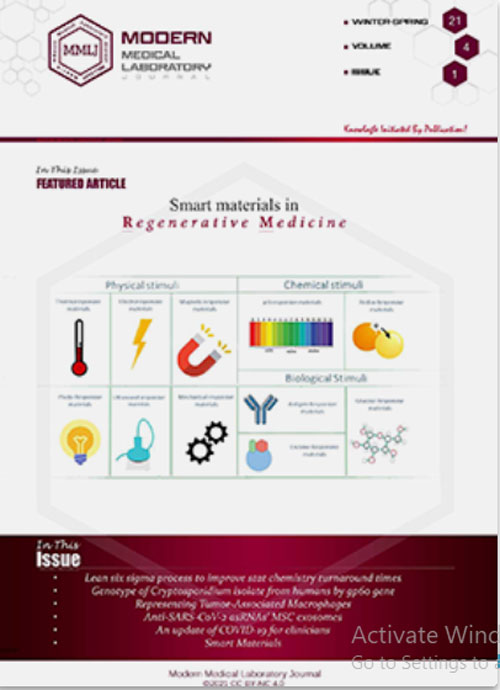فهرست مطالب

Modern Medical Laboratory Journal
Volume:4 Issue: 2, Summer-Fall 2021
- تاریخ انتشار: 1400/08/10
- تعداد عناوین: 6
-
Pages 1-15
So far, many studies have been conducted on the importance of expressing different genes in humans and zebrafish. In this regard, the expression of OCT4, HOX and SOX genes as influential genes in the embryonic period is very thought-provoking. At different embryonic stages, including morula, middle blastula, gastrula, and segmentation, the expression of these genes is very important in the growth, immunity, tissue repair, and viability of different cells. The aim of this study was to investigate the expression of common genes between humans and zebrafish in the embryonic period and their efficiency in different parts of the body.
Keywords: Gene expression, Zebrafish, Embryonic development, OCT4, HOXA10, SOX9 -
Pages 19-27
Novel therapeutic options such as adoptive immunotherapy have been progressed drastically for treating hepatocellular carcinoma (HCC). Chimeric antigen receptor T cell (CAR-T) therapy is a kind of adoptive immunotherapy that has been associated with promising results in hematopoietic malignancies. However, its application is associated with some obstacles in solid tumors, including heterogeneity of tumor antigens, immunosuppressive microenvironment, and serious adverse complications. In recent years, some progress has been made in this regard, and several preclinical and phase I clinical trial studies have been conducted concerning the application of CAR T-cells in solid tumors. This study will review the possibilities of CAR T cell therapy in HCC, the most common primary liver cancer associated with high morbidities and mortality globally.
Keywords: Hepatocellular Carcinoma, Cancer Immunotherapy, Adoptive Cell Therapy, Chimeric Antigen Receptor (CAR) T-cells -
Pages 28-35
New natural substances obtained from scorpion venoms could be promising approaches for the treatment of cancers. Scorpion venom is a fully mixed compound that containing enzymes, non-enzymes, ions, and other organic compounds that induces apoptosis and necrosis in mammalian cells. In this study, the cytotoxicity effects, redox potential, and the ability of apoptosis induction of Odontobuthus bidentatus scorpion venom on MCF-7 cells were investigated. To do this, the MCF-7 cells were treated with the scorpion venom. MTT and neutral red assays was used to evaluate the cytotoxicity. Catalase, GSH and NO assays are used to determine the cells redox potential. Caspase-3 and cytochrome c release assays were exploited to investigate the apoptosis. The results of MTT and neutral red tests showed that O. bidentatus crude venom has cytotoxic effects on MCF-7 cells. Moreover, the results of catalase, GSH and NO assays showed that the crude venom could change the redox potential of MCF-7 cells, dose dependently which eventually lead to apoptosis. Also, the results of caspase-3 and the release of cytochrome c confirmed cell apoptosis. These results suggest that O. bidentatus venom is a suitable source of apoptosis-inducing compounds.
Keywords: Odontobuthus bidentatus scorpion venom, MCF-7 cell line, Redox potential, Apoptosis induction -
Pages 36-39Introduction
The aim of this work is to present the results of a comparative study between the determination of glycated hemoglobin (HBA1C) on the ADAMS A1c® (ARKRAY) and Capillarys 2 Flex Piercing® (SEBIA).
Materials and methods310 venous blood samples were randomly selected from routine HBA1C tests. The HBA1C assay was performed on ADAMS A1c® (ARKRAY) and Capillarys 2 Flex Piercing® (SEBIA) during the same day. The data obtained were analyzed by the statistical software MedCalc Version 15.1.0.
ResultsThe results obtained show a good correlation between the 2
methodsthe equation of the Passing-Bablok line is of type Y (Capillarys 2 Flex Piercing®) = -0.550 + 1.119 X (ADAMS A1c) the 95% confidence interval of this slope is -0.6467 to - 0.4414 with r = 0.982 and p <0.0001. The Bland-Altman plot shows that the average bias between the two methods is in the order of 0.3 and that the difference between the Capillarys and HPLC measurements of Hba1c is in the range of +1.96 to -1.96 and the Deming regression equation Y (Capillarys 2 Flex Piercing®) = -0.3388 + 1.0911 X (ADAMS A1c).
ConclusionOur study shows a good agreement of HBA1C results between the Capillarys 2 Flex Piercing® (SEBIA) and ADAMS A1c® (ARKRAY). Laboratory work requires professionals to take into account variations in results when changing methods in their routine work by comparing their results on the various methods.
Keywords: Glycatedhaemoglobin, Assay, Comparison, ADAMSA1c®(ARKRAY), Capillarys2FlexPiercing®(SEBIA) -
Pages 40-49Introduction
Cleft lip and palate is one of the most common congenital anomalies that affect the jaw, as well as the most common defects related to the lips and palate.
ObjectiveThis study investigated the economic, social, and family factors affecting cleft palate.
Materials and MethodsPubMed, Google Scholar, Science Direct, and “SID” databases were used to investigate the correlation between births of children with cleft lip and palate and economic and social factors of the family. Finally, the most relevant titles and abstracts of articles were chosen to write this article.
Findings and Conclusion:
In the present study, 13 studies were reviewed, and various factors were evaluated. The results showed a correlation between consanguineous marriage, genetics, smoking, no consumption of folic acid, increasing maternal age, poverty, and low education.
Keywords: Cleft Palate, Cleft Lip, Biological Hazards, Economic Factors, Social Factors, Family Factors

